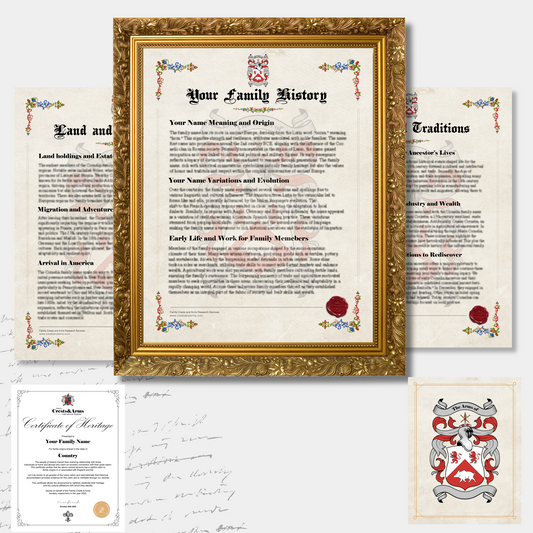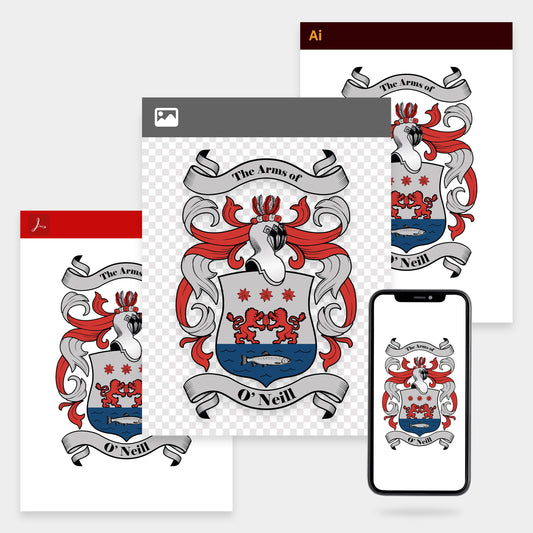Creating a family crest - blending art and history
Creating a family crest is more than just an exercise in artistic creativity. It is a voyage into the heart of history, a journey into the realm of heritage, tradition, and symbolic representation.
This process, which may seem simple on the surface, is in fact brimming with complexities, intricacies, and subtleties.
At its core, a family crest, often referred to as a "coat of arms," is a collection of officially documented symbols, colors, and design elements, each possessing a historical significance and a particular meaning.
While our team re-creates crests from exact historical standards, some people may want to create their own design.
Understanding the language and rules of heraldry, the ancient practice from which these crests originated, is crucial in the creation of a meaningful and authentic family crest.
In this expanded guide, we will take a deep dive into the process of creating a family crest, the importance of understanding heraldry, and why getting help from experts can be a great way to navigate this exciting but challenging journey.
The Art and History of Heraldry
Heraldry, at its most basic, is the practice of devising, granting, displaying, describing, and recording coats of arms and heraldic badges.
It's an art form steeped in tradition and filled with symbolism that began in the Middle Ages, providing a way for knights to identify themselves and each other on the battlefield and at tournaments.
However, over the centuries, heraldry evolved into more than just an identification system. It became a method of signaling a person's accomplishments, lineage, and values, providing a visual narrative of a family's history and heritage.
The creation of a family crest today is an extension of this tradition, linking the present with the past and providing a bridge to future generations.
The Intricate Elements of a Family Crest
A family crest typically consists of several components, each playing a vital role in the overall design and carrying its own set of meanings. These components include:
-
Shield: The shield, or escutcheon, is the heart of the crest, the main canvas upon which various symbols (referred to as 'charges' in heraldry) and colors (called 'tinctures') are displayed.
-
Helmet and mantling: Positioned atop the shield, the helmet represents the rank of the bearer, while the mantling, depicted as a drapery around the helmet, symbolizes protection.
-
Crest: This is the element positioned atop the helmet. Crests vary widely and can be animals, plants, or other symbolic objects.
-
Supporters (where applicable): These are figures of humans, beasts, or mythical creatures that appear to be holding up the shield.
-
Motto (if included): Many family crests include a motto, a phrase or sentence that encapsulates the family's beliefs, ethos, or aspirations.
-
Compartment: This is the base upon which the supporters stand, and it can be composed of various landscapes or objects.
Each of these components contributes to the telling of a family's unique story - their history, their values, and the legacy they have inherited and will pass on.
Unveiling the Meaning: Heraldic Symbols and Colors
One of the most captivating aspects of heraldry is its symbolic language. In this language, every color, pattern, and symbol carries a strict and specific meaning. For example, in the world of heraldry, the color gold (or "Or") symbolizes generosity and elevation of the mind. Similarly, a lion, a common symbol, stands for qualities like bravery, nobility, royalty, strength, and valor.
There are many such symbols and colors in heraldry, each telling its own tale. Understanding these symbols is like learning a new language - a language that allows you to articulate your family's
story and values visually and symbolically. Before embarking on the creation of your family crest, it's worth studying the language of heraldry to be able to make informed decisions about which elements best represent your family's heritage and values.
There are numerous resources available online that can aid in this study. The American Heraldry Society offers a wealth of information on the symbols, colors, and rules of heraldry. The Heraldry Society in the UK is another excellent resource, offering courses, books, and research materials that can deepen your understanding of heraldry.
DIY or Expert Help: The Path to Creating Your Family Crest
With a foundational understanding of heraldry, you're well on your way to creating a unique family crest. But even with a solid understanding, the task can still be quite challenging. The rules of heraldry are complex and nuanced, and a seemingly minor mistake can significantly alter the meaning of your crest.
Thankfully, there's no need to go it alone. Expert help is available, and it can be an invaluable asset on your heraldic journey. Services like crestsandarms.com specialize in the research, design, and illustration of heraldry. With a team of skilled and knowledgeable heraldic artists and historians, they can guide you through the process, help you make informed decisions, and ensure that your family crest is not just beautiful and unique, but also historically accurate, meaningful, and true to the principles of heraldry.
Choosing to create a family crest is an exciting endeavor. However, it's not a task to be undertaken lightly. It requires research, time, creativity, and a deep understanding of heraldic tradition. Yet, the reward is immense: a unique and timeless symbol of your family's history, values, and aspirations. A family crest is more than just a beautiful design. It's a tangible connection to your family's past, a symbolic representation of your family's present, and a legacy that can be passed on to future generations.
Acquiring Your Blank Shield
The first step in creating your family crest is to acquire a blank shield. This shield, also known as the escutcheon, serves as the canvas for your design, and it's where the majority of your chosen symbols or 'charges' will be placed.
The shape of the shield can vary and often reflects the era or country of origin that you wish your crest to represent. Classic European designs, for instance, feature a heater shield design, a silhouette that resembles the bottom of a flat iron. On the other hand, if you're inspired by the elaborate full achievements of the late Renaissance, a cartouche or oval-shaped shield may be more fitting.
You can purchase blank shields from specialized retailers, or if you're artistically inclined, you may choose to craft your own. Remember, the shield is the heart of your crest, so choose a shape and size that resonates with you and can accommodate your chosen symbols meaningfully.
Choosing Your Symbols and Icons
Once you have your shield, the next step is to choose the symbols, or charges, you wish to display. This is where your study of heraldic symbolism really comes into play. The charges you choose should reflect the qualities, values, and history of your family. They could be animals, plants, objects, or geometric shapes, each carrying its own unique symbolism.
For instance, a bear often symbolizes strength and bravery, an oak tree represents strength and endurance, and a key can symbolize knowledge and guardianship. Research the meanings behind various symbols to ensure your chosen charges align with the story you want your crest to tell.
Remember, heraldry is an art of exact details. Even the color of your charges and the field of your shield (the background color) hold significance. In heraldry, colors are known as 'tinctures,' and each has its own symbolic meaning. For example, red, or 'gules,' signifies military strength and magnanimity, while blue, or 'azure,' represents loyalty and truth.
Positioning Your Symbols
The position of symbols on a family crest is not arbitrary; even here, meaning abounds. For example, an animal positioned 'rampant' (rearing up on one hind leg) indicates a warrior or protector and is a symbol of fighting spirit and strength. An animal 'passant' (walking with one front foot raised) signifies an individual on a journey or quest for knowledge or faith.
In the context of other charges, the arrangement and interaction of these elements also carry weight. A lion positioned above a key, for instance, might indicate authority over knowledge or wisdom.
As you design your crest, consider not just what symbols to include but how to position them. Think of your shield as a stage, and your charges as actors playing out the story of your family history. Through their positions and interactions, they narrate your unique tale.
Whether you're hand-drawing your crest or using digital software, be sure to take your time and consider each element's placement. Crafting a family crest is an art of careful consideration and symbolism, a story told through visuals, and every detail contributes to that narrative.
Conclusion
Creating a or finding your family crest is a journey through time and heritage, a tangible connection to the past, and a legacy for the future. It's an exciting, challenging, and rewarding endeavor, steeped in history and tradition. While the journey requires an understanding of the complexities and intricacies of heraldry, it's a path well worth traveling.
Expert help, such as that provided by crestsandarms.com, can be invaluable in navigating the intricacies of heraldry, guiding you towards creating a family crest that is not only visually appealing but also historically accurate and symbolically meaningful. Whether you're starting from scratch or have a rough idea of what you want your family crest to look like, don't let the complexities of the process discourage you. With patience, research, and possibly a little expert guidance, you can create a crest that truly embodies your family's unique story and leaves a lasting legacy for generations to come.
Shop our bestsellers
-
Research + Family Crest Print
Regular price From $33.00 USDRegular priceUnit price per$54.00 USDSale price From $33.00 USD Sale
Sale -
Premium Crest & History Package
Regular price From $199.00 USDRegular priceUnit price per
-
Research + Double Crest
Regular price From $49.00 USDRegular priceUnit price per$54.00 USDSale price From $49.00 USD Sale
Sale -
Digital Crest Files
Regular price $33.00 USDRegular priceUnit price per$49.00 USDSale price $33.00 USD Sale
Sale




